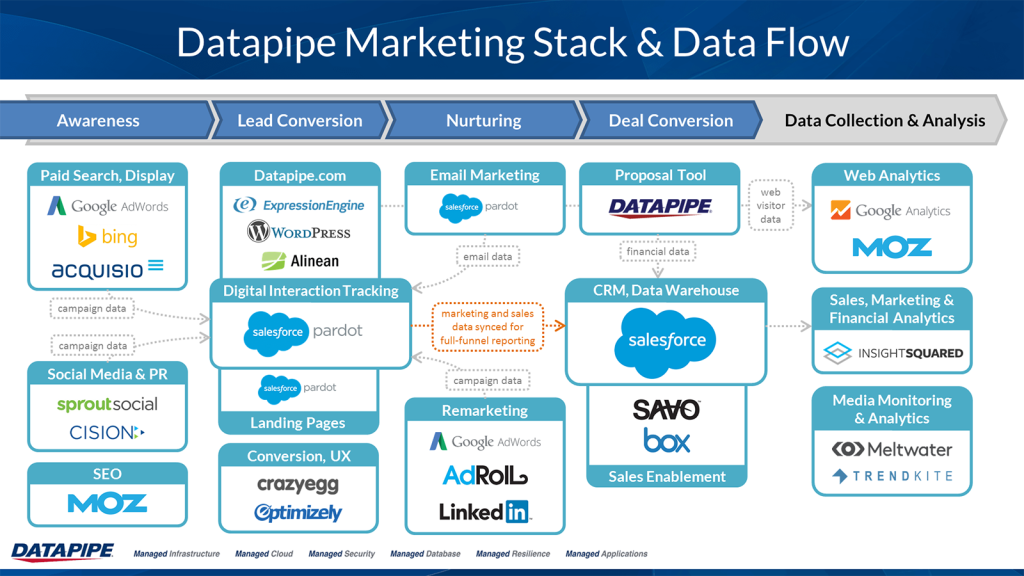
As CMOs continue to establish themselves as customer experience and engagement leaders within their organizations, and driveing the digital interactions with customers, being able to make sense of the growing martech beast is a necessity—not a nice to have.
“Marketing technology stacks—the collection of marketing technology products that your company uses and how they’re conceptually organized—are an important part of modern marketing management,” writes Scott Brinker, a marketing technologist, CTO, and program chair of the MarTech Conference, on his chiefmartec.com blog.
Each year, Scott’s massive Marketing Technology Landscape Supergraphic shows the current state of marketing technology, including vendors in categories such as mobile marketing, social media marketing, customer experience, influencer marketing, web and mobile analytics, marketing automation…and too many more to list here.
To help CMOs decide which technologies they should add to their marketing stack, we’ve put together a list of helpful hints and resources.
Deciding what should be in your martech stack
With so many technologies to choose from, narrowing down the choices can seem like an impossible task. Fortunately, marketers are a sharing bunch, and there’s a lot of information out there to point you in the right direction.
The annual Stackies program awards prizes to marketers who provide the best representation of their marketing tech stack in a single diagram. Checking out last year’s award winners is a useful place to look for inspiration. Here are the types of solutions the first place winner, Datapipe included in their stack:
- Paid search and display
- Social media and PR
- SEO
- Email marketing
- Remarketing
- CRM and data warehouse
- Sales enablement
- Web analytics
- Sales, marketing and financial analytics
Learn what’s in MongoDB CMO Meagan Eisenberg’s martech stack, check out her AMA in our VIP community.
How to evaluate marketing technologies
Now that you have an idea of which technologies you might want to consider for your stack, it’s time to figure out what vendors will meet your needs.
Scott shared his method of evaluating software vendors with Search Engine Land: “I start by Googling the topic, looking for articles, vendors, reviews. I check out trade shows and associations. I look for the influencers and follow the dots of who they connect with.”
Here’s a few places you can crowdsource some information on about specific technology options:
- Gartner’s Magic Quadrants are published or updated throughout the year, with each Quadrant focused on a specific technology, such as digital marketing hubs, marketing resource management, business intelligence and analytics platforms, web content management and many more.
- Forrester Waves is Forrester’s evaluation of hardware, software or service vendors in a particular market. These cover everything from customer loyalty solutions to cloud business intelligence platforms and customer insights service providers.
- Consulting crowdsourced review sites such as G2Crowd, TrustRadius, GetApp, Spiceworks, ITCentralStation, and SoftwareAdvice will show you how peers rate their technology investments. A good Quora search can also help.
Tips for building a cohesive martech stack
Once you’ve established your technology priorities, you need to know how to optimize your stack. We interviewed Jascha Kaykas-Wolff and Kobie Fuller, experienced marketing leaders and creators of interactive martech visualization tool GrowthVerse, to explain how to successfully bring your strategy and technology together.
Here’s a few of their best tips and insights:
- Understand what the various technology tools can do, and how they integrate with your existing technology. Consider how they each measure results, and how you’ll gauge and define success with each tool, and across your entire martech stack.
- Define your strategy first—including short- and long-term goals—and then test out various technologies to find the ones that will help you reach those goals.
- Build a marketing team that includes a mix of people with technical skills, as well as creative marketing backgrounds. Not every tool is going to be easy to use or generate results without effort from both sides of the brain.
- Develop an Agile Marketing approach so you can streamline business processes, measure the impact of campaigns more quickly, and make adjustments on the fly.
Next Steps
The sea of marketing technology is getting choppier and shows no signs of calming. Make sure you’re prepared to ride the waves by carefully evaluating and choosing the technology that will best help you reach your strategic goals.
 Free eBook: How Top CMOs Are Adapting To The New Marketing Landscape
Free eBook: How Top CMOs Are Adapting To The New Marketing Landscape
This eBook features key insights from forward-thinking CMOs and marketing leaders on:
- The changing role of the CMO
- Delivering an exceptional customer experience
- Cultivating a customer-obsessed company culture
- Increasing customer retention and loyalty
- Enlisting the help of advocates to build your brand and generate revenue













































